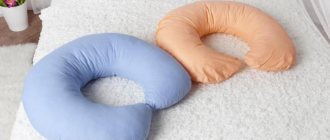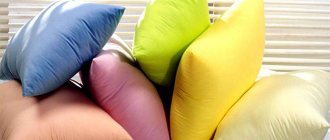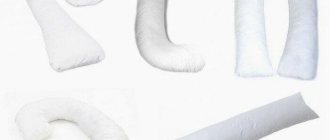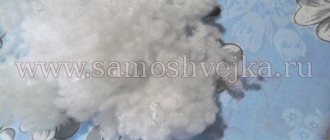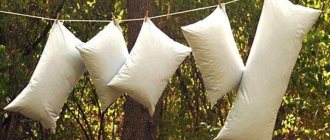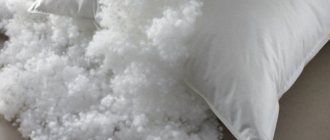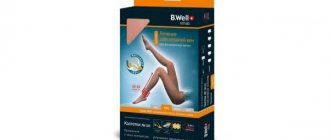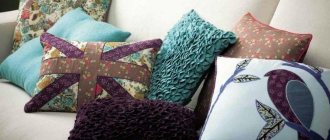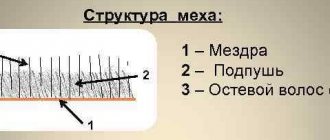When you mention insulation for clothing, one of the first things that comes to mind is holofiber.
In recent years, it has confidently taken a leading position among fillers.
In addition to being used for sewing jackets and down jackets, it is used in the furniture and construction fields.
The raw material for its production is the familiar plastic, from which almost all beverage containers are made, including recycled ones.
In this article we will explain in detail:
- what kind of material is this;
- does it relate to tissues;
- what is it made from;
- what properties does it have?
- how much does holofiber cost?
Flaws
Oddly enough, holofiber does not have many disadvantages. Some ordinary people notice that it can be too hot in clothes or bedding with holofiber insulation. But the essence lies in the physiological characteristics of individual individuals.
When washed in aggressive mode or in hot water, holofiber insulation may become less elastic and more rigid.
Holofiber types, properties, composition
Holofiber is available in the form of: sheet (plate), balls and canvas. Plates are most often used in construction, balls are used to fill pillows and blankets, and canvas is used to insulate outerwear. Material composition – 100% polyester (polyester).
The filler has the following properties:
- breathability;
- hygiene;
- resistance to deformation;
- lightness and softness;
- heat-regulating properties;
- hypoallergenic;
- environmental friendliness;
- strength;
- durability;
- ease of care;
- resistance to biological microorganisms.
Price for 1 kg
Holofiber is a material with an attractive price. To understand the price of filler, you can consider approximate offers for Russian cities . The table shows prices for 1 kg of 2nd grade holofiber:
| City | Price per 1 kg/rub |
| Moscow | 250 |
| Saint Petersburg | 250 |
| Krasnodar | 160 |
| Volgograd | 150 |
| Ekaterinburg | 150 |
| Tomsk | 130 |
| Novosibirsk | 150 |
| Vladivostok | 250 |
Feather pillow weight
The quality of the filler used and its performance properties directly depend on the weight of the feather pillow. When purchasing a product in a regular store, you need to shake it. If the product quickly regains its shape, it means it uses a high-quality fine nib.
How much does a feather pillow weigh 70x70, 50x70
The approximate weight of a feather pillow with dimensions 70x70 will vary between 2.5-3 kg, and products measuring 50x70 will weigh from 2 to 2.5 kg.
Holofiber or padding polyester: what is the difference?
Holofiber has improved characteristics compared to padding polyester: it has better thermal conductivity, lighter weight, and is easy to maintain. But in addition to their properties, materials can easily be distinguished from each other by touch.
Externally, padding polyester consists of polyester fibers laid in parallel layers, glued or thermally bonded to each other. If you feel the insulation under the top layer of clothing and try to pull it to the side, the padding polyester will begin to tear. At the same time, holofiber consists of small balls located randomly in relation to each other. Such insulation will never break when stretched, since the balls are easily separated.
You can learn more about padding polyester from a separate article.
Areas of use
First of all, holofiber was invented as an improved filler for textile production. It is more technologically advanced to use than synthetic winterizer and natural insulation materials (wool, batting, etc.). Its areas of application are varied - from sewing outerwear to construction purposes.
Areas of application depend on its type :
- Soft . Density 150 g/m2. Light and fluffy. Used for outerwear as a filler.
- Average . Density 200 g/m2. More dense and heavier. It is mainly used for the production of home textiles and for the top layer in upholstered furniture structures, filling bulk products.
- Hard . Density 200 g/m2. Dense, shape-stable. Used as a filler for upholstered furniture.
It should be noted that the use of 2nd grade holofiber is limited due to its technical characteristics, which are inferior to 1st grade material.
Permitted areas of use of insulation from PET waste include:
- construction - it is much lighter than foamed polyethylene and other analogues, in addition it has an attractive price, it is used as insulation for walls, ceilings, roofing, etc.;
- furniture - used as a rigid upholstery material for furniture production, since holofiber made from thick threads of recycled PET is quite durable;
- as a filler for inexpensive clothing - for sewing special clothing with a short service life, it is permissible to use insulation from recycled materials.
Filler production technology
The production cycle involves several stages:
- selection of raw materials;
- fiber preparation;
- holofiber molding;
- finishing (coating) with silicone;
- package.
Holofiber is made from virgin and recycled PET. Fundamentally, the equipment for the production of holofiber itself is the same. The settings of process parameters may differ: temperature, feed rate, etc.
That is, filler molding machine is universal and can work on polyester fiber of any nature. Pure polyester fiber is ideal for any purpose, it is light, transparent and clean. Threads made from regranulate most often have a grayish tint, so they are suitable mainly for technical products.
The decisive factor is the cost of raw materials. Recycled polyester is cheaper , and, in addition, serious competition in the PET recycling market is pushing recyclers to improve product quality.
You can buy ready-made fiber, or
you can produce it yourself .
A more detailed description of the process of forming fibers can be found in the articles “Synthetic flakes” and “Flex flakes: types, production, application.”
A significant advantage of making threads yourself is the ability to manage quality .
The serious disadvantages are very expensive equipment and the need for qualified personnel.
At the fiber preparation stage
polyester threads are pre-cut and combed using a carding machine. This is how the fibers acquire a three-dimensional structure.
When molding holofiber
There are currently 2 technologies in use:
- calender method - pieces of polyester are fed into a narrow gap between two shafts, which rotate at different speeds, the small shaft guides the fibers and rotates faster, and the large (heated) shaft - slower, it picks up the threads and twists them into balls;
- aerodynamic method - cut pieces are fed into a pipe diffuser and move towards the outlet in a stream of hot air, the threads are curled up under the influence of heat (one of the fundamental properties of polymers works here - when heated, the interaction between the polymer links is weakened, and the molecule twists into its natural state - a ball) .
Finishing or application of silicone liquid occurs inside the chamber using spray guns.
By forming a thin surface layer, silicone protects the surface of the holofiber from moisture, absorption of unpleasant odors and caking.
Finished products are packaged in polyethylene .
To increase compactness, the bags are packed under vacuum.
